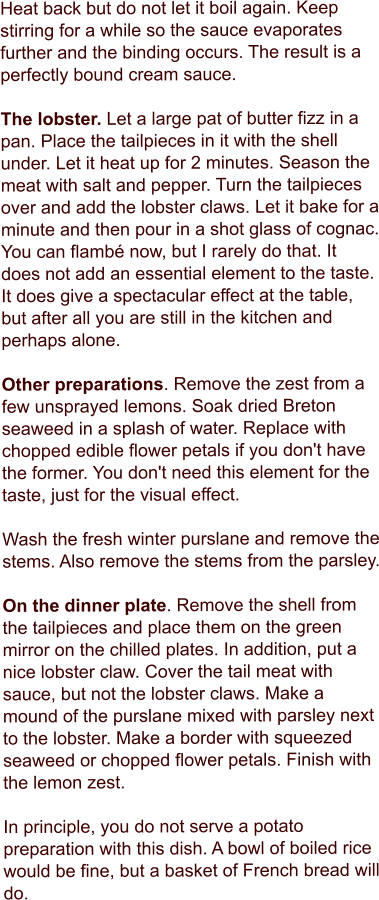

lobster in the style of Cherbourg
First make the ring. Blanch 250 g of leaf spinach briefly in
boiling water. Rinse immediately in a sieve under running cold
water to fix the color. Bring two glasses of vegetable stock to
the boil. Add the squeezed spinach. Add 2 grams of agaragar
and leave to boil for another minute.
Pour this preparation with a spoon into large flat plates. Make
sure the rings are nicely rounded and do not spill on the
edges. Leave the plates to stand for a while until they start to
stiffen up. Now you can easily move them to a cool place or
the fridge to store them for later use.
The lobsters. Halve freshly cooked lobsters lengthwise. Catch
the moisture. Break off the claws and also the tail without
removing the shell. Remove the intestinal tract in the tail meat.
Remove the sachet in the head. Spoon the rest of the contents
with the collected fluid.
Take a meat hammer and break the shell of the claws. With a
nutcracker or a lobster cracker it goes too, but the risk of
damaging the meat in the claws is higher. Take the meat out
carefully and pour the released liquid with the rest of the gray
liquid. If there is calf in the lobster, you may add it.
The sauce. Press the lobster liquid through a fine sieve. You
will have about 25 cl of 'clean' liquid left over. Add twice as
much cream and bring this combination to the boil in a
saucepan. Season with pepper from the mill and sea salt. Pour
in equal amounts of calvados and sweet vermouth to taste and
let the alcohol evaporate. Reduce further to 2/3.
Pluck the tarragon leaves off the stem and chop them finely.
You need a handful of chopped tarragon. Make a liaison of two
egg yolks with a dash of cream. Take the pan off the heat, stir
in the liaison and then the tarragon.
tarragon
eggs
butter
unsprayed lemon
Breton seaweed
or edible flowers
purslane
parsley

Admit it, 'lobster in the style of Cherbourg' sounds
incredibly boring compared to the frivolous 'demoiselles
de Cherbourg à la crème'? In this case, ‘les demoiselles’,
the misses, are small lobsters. You can find them on the
menu of many restaurants in Normandy. What makes this
preparation special is undoubtedly the cream sauce.
Chances are that your guests will clean out their dinner
plate with a piece of bread.


leaf spinach
vegetable stock
agaragar
lobsters
full cream
salt and pepper
calvados
sweet vermouth




lobster
in the style of
Cherbourg
tarragon
eggs
butter
unsprayed lemon
Breton seaweed
or edible flowers
purslane
parsley
First make the ring. Blanch 250 g of leaf
spinach briefly in boiling water. Rinse
immediately in a sieve under running cold
water to fix the color. Bring two glasses of
vegetable stock to the boil. Add the squeezed
spinach. Add 2 grams of agaragar and leave to
boil for another minute.
Pour this preparation with a spoon into large
flat plates. Make sure the rings are nicely
rounded and do not spill on the edges. Leave
the plates to stand for a while until they start to
stiffen up. Now you can easily move them to a
cool place or the fridge to store them for later
use.
The lobsters. Halve freshly cooked lobsters
lengthwise. Catch the moisture. Break off the
claws and also the tail without removing the
shell. Remove the intestinal tract in the tail
meat. Remove the sachet in the head. Spoon
the rest of the contents with the collected fluid.
Take a meat hammer and break the shell of the
claws. With a nutcracker or a lobster cracker it
goes too, but the risk of damaging the meat in
the claws is higher. Take the meat out carefully
and pour the released liquid with the rest of the
gray liquid. If there is calf in the lobster, you
may add it.
The sauce. Press the lobster liquid through a
fine sieve. You will have about 25 cl of 'clean'
liquid left over. Add twice as much cream and
bring this combination to the boil in a
saucepan. Season with pepper from the mill
and sea salt. Pour in equal amounts of
calvados and sweet vermouth to taste and let
the alcohol evaporate. Reduce further to 2/3.
Pluck the tarragon leaves off the stem and
chop them finely. You need a handful of
chopped tarragon. Make a liaison of two egg
yolks with a dash of cream. Take the pan off
the heat, stir in the liaison and then the
tarragon.


Admit it, 'lobster in the style of Cherbourg'
sounds incredibly boring compared to the
frivolous 'demoiselles de Cherbourg à la
crème'? In this case, ‘les demoiselles’, the
misses, are small lobsters. You can find
them on the menu of many restaurants in
Normandy. What makes this preparation
special is undoubtedly the cream sauce.
Chances are that your guests will clean out
their dinner plate with a piece of bread.


leaf spinach
vegetable stock
agaragar
lobsters
full cream
salt and pepper
calvados
sweet vermouth
Ingredient
quantities
are
only
listed
when
absolutely
necessary.
Making
the
right
choices
when
following
a
recipe,
with
your
fiery
passion
for
cooking,
that's
creative cooking
!

















